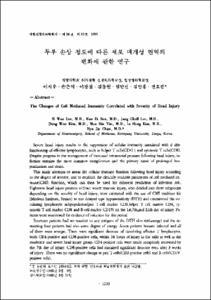KUMEL Repository
1. Journal Papers (연구논문)
1. School of Medicine (의과대학)
Dept. of Neurosurgery (신경외과학)
두부 손상 정도에 따른 세포 매개성 면역의 변화에 관한 연구
- Alternative Author(s)
- Son, Eun Ik; Lee, Jang Chull; Kim, Dong Won; Yim, Man Bin; Kim, In Hong; Chun, Hyo Jin
- Journal Title
- 대한신경외과학회지
- ISSN
- 1225-8245
- Issued Date
- 1995
- Abstract
- Severe head injury results in the suppression of cellular immunity associated with dysfunctioning of effector lymphocytes, such as helper T cells(CD4) (and cytotoxic T cells(CD8). Despite progress in the management of increased intracranial pressure following head injury, infection remains the most common complication and the primary cause of prolonged hospitalization and death.
This study attempts to assess the cellular immune function following head injury according to the degree of severity, and to establish the clinically available parameters of cell mediated immune(CMI) function, which can then be used for coherent prediction of infection risk. Eighteen head injury patients without severe systemic injury, who divided into three subgroups depending on the severity of head injury, were estimated with the use of CMI multitest kit(Merieux Institute, France) to test delayed-type hypersensitivity(DTH) and enumerated the circulating lymphocyte subpopulation(pan T-cell marker CD3, helper T cell marker CD4, cytotoxic T cell marker CD8 and B-cell marker CDl9) on the 1st, 7th, and 21th day of injury. Patients were monitored for evidence of infection for this period.
Fourteen patients had no reaction to any antigens of the DTH skin test(anergy) and the remaining four patients had also some degree of anergy. Seven patients became infected and all of them were anergic. There were significant decrease of circulating effector T Iymphocytes, both CD4-positive and CD8-positive cells, within 24 hours of injury in the mild as well as the moderate and severe head injury group. CD4-positive cells were nearly completely recovered by the 7th day of injury. CD8-positive cells had sustained significant decrease even after 3 weeks of injury. There was no significant change in pan T-cells(CD3-positive cells) and B-cells(CDl9-positive cells).
The results suggest that DTH skin test and effector T cell enumeration are both relatively simple and highly sensitive parameters for monitoring CMI function. Especially, anergy of DTH skin test can be used for indicator to predict risk of infection. Mild as well as moderate and severe head injuries may result in the suppresion of cellular immunity associated with the dysfunctioning of effector T cell.
최근 6개월간의 계명대학교 신경외과에 입원한 심한 전신 손상을 동반하지 않은 두부 손상 환자와 비교군에서 CMI multitest kit를 이용한 DTH 피부검사와 환자의 말초 혈액에서 T세포 및 그 아형과 B세포의 백분율을 조사함으로써 외상정도와 감염과의 상관 관계를 연구한 바 세포 매개성 면역 저하의 지표로 effecter T 임파구인 helper T세포(T4)와 cytotoxic T세포(T8)의 감소 DTH 피부검사에서 반응정도의 감소가 이용될 수 있음을 관찰 하였으며 이러한 현상은 종래의 심한 두부 손상 후 세포 매개성 면역 기능의 저하에 대한 보고와는 달리 비교적 경미한 두부 손상에 의해서도 유발될 수 있음을 알았다. 또한 DTH 피부검사의 Anergy 반응은 감염 가능성을 예측하는데 도움을 주는 지표로 이용 될 수 있음도 보여 주었으며, 통계적 유의성은 떨어지나 effector T 임파구의 백분율 검사는 외상 정도와 비례해 감소하는 경향을 보여 주었다.
그러나 두부 손상 정도가 심할수록 감염율이 증가하는 소견과 연관하여 설명하기에는 DTH 피부검사의 외상정도에 따른 차이성이나, effector T 세포 백분율 측정의 감염군과 비감염군간의 비교에서 각각 특이성이 떨어짐을 보이므로 앞으로 이에 대한 보완이 요구되며, 아울러 세포 매개성 면역이외의 감염에 중요하게 관여하는 다른 요인도 고려한다면, 두 검사 모두 두부 외상 환자에서 세포 매개성 면역성 조사나 환자의 감염에 대한 예측과 치료에 필요한 유용한 정보를 얻는데 비교적 감수성 높은 검사로 사료 되었다.
- Alternative Title
- The Changes of Cell Mediated Immunity Correlated with Severity of Head Injury
- Publisher
- School of Medicine
- Citation
- 이시우 et al. (1995). 두부 손상 정도에 따른 세포 매개성 면역의 변화에 관한 연구. 대한신경외과학회지, 24(10), 1235–1242.
- Type
- Article
- ISSN
- 1225-8245
- 파일 목록
-
-
Download
 oak-bbb-1701.pdf
기타 데이터 / 435.1 kB / Adobe PDF
oak-bbb-1701.pdf
기타 데이터 / 435.1 kB / Adobe PDF
-
Items in Repository are protected by copyright, with all rights reserved, unless otherwise indicated.